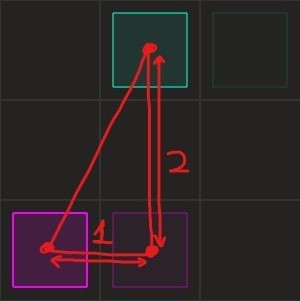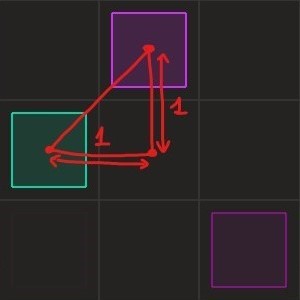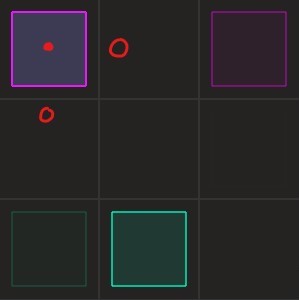Basic mapping: Patterns
Learn how to use patterns to make maps
Common terms
- Spacing: The distance (Manhattan distance) between 2 notes. It can be on the X-axis (horizontal) or the Y-axis (vertical).
- Quantum: A setting which allows notes to be placed off the regular 3x3 grid's limits.
Introduction
In mapping, a pattern is a succession of notes which are usually associated with a sound or rhythmic pattern present in a song.
Therefore, mapping involves turning a song into patterns which can then be played inside the game.
In Rhythia, we can distinguish 2 main types of patterns:
- Jumps, which are
- Slides and spirals, which are contiguous note clusters
Pattern notation
Mappers usually express patterns as letter arrays, where each letter represents its corresponding keybind on the grid.
In said pattern, notes should be hit in reading order (left to right) and one at a time.
Take for example ZAQWE. This pattern should be hit in this order: Z -> A -> Q -> W -> E, and it looks like this in the editor:
Details
Most of the pattern names are made up for explanatory purposes, in most cases, it's faster to use the notation above to describe a pattern. If it's still not enough, you may take a screenshot of the pattern.
Jumps
A jump is a single displacement between 2 notes. We can classify any jump type into subcategories by their spacings'length:
Long jump: At least one of the spacings is longer than 2 blocks.
For example:
Short jump: None of the spacings is longer than 2 blocks. For example:

Stack: Both spacings are equal to 0. For example:

Details
Some notes on jump patterns:
- A long stack (longer than 1/2 or 1 beat) is known as a straight.
- A very fast and repetitive set of jumps is referred to as a vibro, used mostly on hard maps.
- Commonly, the "jump" term refers exclusively to long jumps. Short jumps aren't as common.
We can also break down jumps into subcategories by their movement type:
Straight jumps
These jumps are meant to be followed in a straight line:
- Sidesteps: Jumps of spacing less than 2. Commonly used in easier maps. Example: AZAZ (bottom left corner sidestep)
- Verticals/Horizontals: Jumps of spacing of at least 2. Commonly seen in pattern-wise maps. Example: ZQXWCE (full vertical pattern)
Mixed jumps
These jumps involve both vertical and horizontal movement, one at a time or both simultaneously:
- Diagonals: Jumps which require moving diagonally. If the player needs to move from corner to corner they're called corner jumps.
Example: QC (top left to bottom right) - Star jumps: Jumps which look similar to an 8-pointed star (octagram). It is often hit by spinning in circles. Example: ZWCAEXQD (full star pattern)
- Rotating jumps: Jumps made up by alternating verticals and horizontals with diagonals. This results in a spin kind-of pattern. Example: ZEXWCQDAEZ (full spin pattern)
- Square jumps/Spins: Jumps which go around the grid’s edges. In essence, they're alternated verticals and horizontals. Example: QECZQECZ (2 spins)
- Pinjumps: Jumps which, no matter their length, use a note alternately as an axis and go all over the grid. Example: ZWZDZEZQ (Z axis)
Slides & Spirals
- A slide is a succession of contiguous notes, all of which need to be hit on time. For example:

- A spiral is a succession of slides which usually join at the grid's corners. For example:

INFO
The example above shows only a segment of the spiral. A spiral should loop across the same positions more than once.
Slides which end where they started, like QWEDSAQ are NOT considered to be spirals.
Common examples
Since there's many distinct possibilities for slides and spirals, let's take a look at some examples based on their length in notes (using a 1/4 beat divisor, which is the most common for these patterns).
Short Slides
- Straight slide: 3 vertical/horizontal notes Example: EDC
- Corner slide: 3 contiguous notes which go over a corner Example: AQW (top left)
Medium Slides
- Short S-slide: 5 contiguous notes, which go from corner to corner including the whole middle column and flow like an "S" shape.
Example: EWSXZ (top right to bottom left) - Short U-slide: 5 contiguous notes, which go around half of the grid and flow like a "U" shape. Example: AZXCD (bottom half)
- L-slide: 5 contiguous notes, which go around a corner and flow like an "L" shape. Example: EDCXZ (top right to bottom left)
Long Slides
- S-slide: 8 contiguous notes, which go from corner to corner including all columns and flow like an "S" shape.
Example: EDCXSWQAZ (top right to bottom left) - O-Slide/Spin: 8 contiguous notes, which go around the grid and flow like an "O" shape. Example: QWEDCXZAQ (clockwise spin)
Spirals can also be made by linking slides together, so we didn't consider them here.
How to create longer patterns
To make longer patterns, you must find a way to join smaller patterns together using a note which both patterns have in common, also known as a linking note. For example, QWEDCXZAQ and QWEDSAZXC can be joined at Q, making QWEDCXZAQWEDSAZXC.
You may use the patterns above (or your own!) as building blocks for your map.
INFO
You may save patterns by selecting the notes on the track, then pressing Shift + any numeric key (0-9). To place a stored pattern, simply press the numeric key which has the bound pattern. To clear a binding made previously, press Ctrl + the corresponding numeric key.